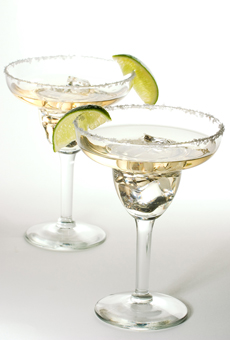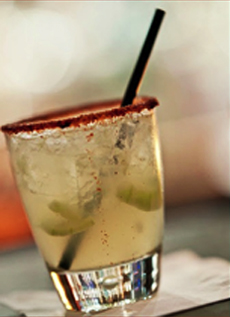FOOD HOLIDAY: National Margarita Day
|
What’s your idea of the perfect Margarita? In anticipation of National Margarita Day, February 22nd, Milagro Tequila asked 100 Margarita drinkers, 51 men and 49 women, to share their preferences.
|
Something different: a chili powder rim instead of salt. Or, mix the two. Photo courtesy Richard Sandoval Restaurants. |
|
|
WHAT’S A MARGARITA GLASS? A Margarita glass (see photo below) is style of cocktail glass used to serve Margaritas and other mixed drinks. It is also repurposed as tableware, to serve dishes from ceviche, guacamole and shrimp cocktail to sundaes and other desserts. The Margarita glass is a variation of the classic Champagne coupe, and was developed specifically for for blended fruit and frozen Margaritas. The capacity is larger than the rocks glass used for classic Margaritas, and the wide rim accommodates plenty of salt. There is no need to own Margarita glasses: rocks glasses are just fine for classic Margaritas, and the larger Collins glasses—or whatever you have—do well for frozen Margaritas. From the Victorian Age until the Second World War, people of means dined very fashionably. Elaborately prepared foods were served on fine tableware with many different utensils—different fork and knife shapes for meat, fish, seafood, and so on. Whew! |
||
 The Margarita glass, actually developed for blended fruit and frozen Margaritas. Photo by Eugene Bochkarev | BSP. |
WHO INVENTED THE FROZEN MARGARITA? The original Margarita began appearing in bars and restaurants along the U.S.-Mexico border in the late 1930s. The first elecric blender had appeared in 1922, and improved upon in 1935 with the invention of the Waring Blender. That device, which could efficiently chop ice, enabled the creation of “frozen” drinks”—a conventional cocktail made in a blender with chopped ice. By the 1960s, slushy soft drinks became the craze among kids and adults alike. The machine to make them was invented by Omar Knedlik in the late 1950s. The World War II veteran from Kansas bought his first ice cream shop after the war. In the late 1950s he bought a Dairy Queen that did not have a soda fountain, so he served semi-frozen bottled soft drinks, which became slushy and were immensely popular. This gave him the idea to create a machine that made slushy sodas, resulting in the ICEE Company. Yet no one made the leap to using the machine for frozen cocktails. At that time, frozen Daiquiris and Margaritas were made by bartenders in a blender with ice cubes. But it wasn’t a great solution. |
|
|
A young Dallas restaurant manager, Mariano Martinez, couldn’t master the consistency of frozen Margaritas to the satisfaction of his customers—who no doubt were comparing them to the Slushies from 7-Eleven. His bartenders complained that the blender drinks were too time-consuming to make. One day in 1971, Martinez stopped for a cup of coffee at a 7-Eleven and saw the Slurpee machine. The light bulb flashed on, and Martinez bought and retrofitted an old soft-serve machine, porting the technology to make frozen Margaritas. The rest is history. The frozen Margarita was responsible for the growth of tequila in America, as well as the growth of Tex-Mex cuisine to go with all those frozen Margaritas. According to Brown-Forman, in 2006 the Margarita surpassed the Martini as the most ordered alcoholic beverage, representing 17% of all mixed-drink sales. Martinez’ historically significant, original machine was acquired by The National Museum of American History in 2005.
|
||



